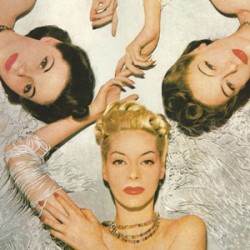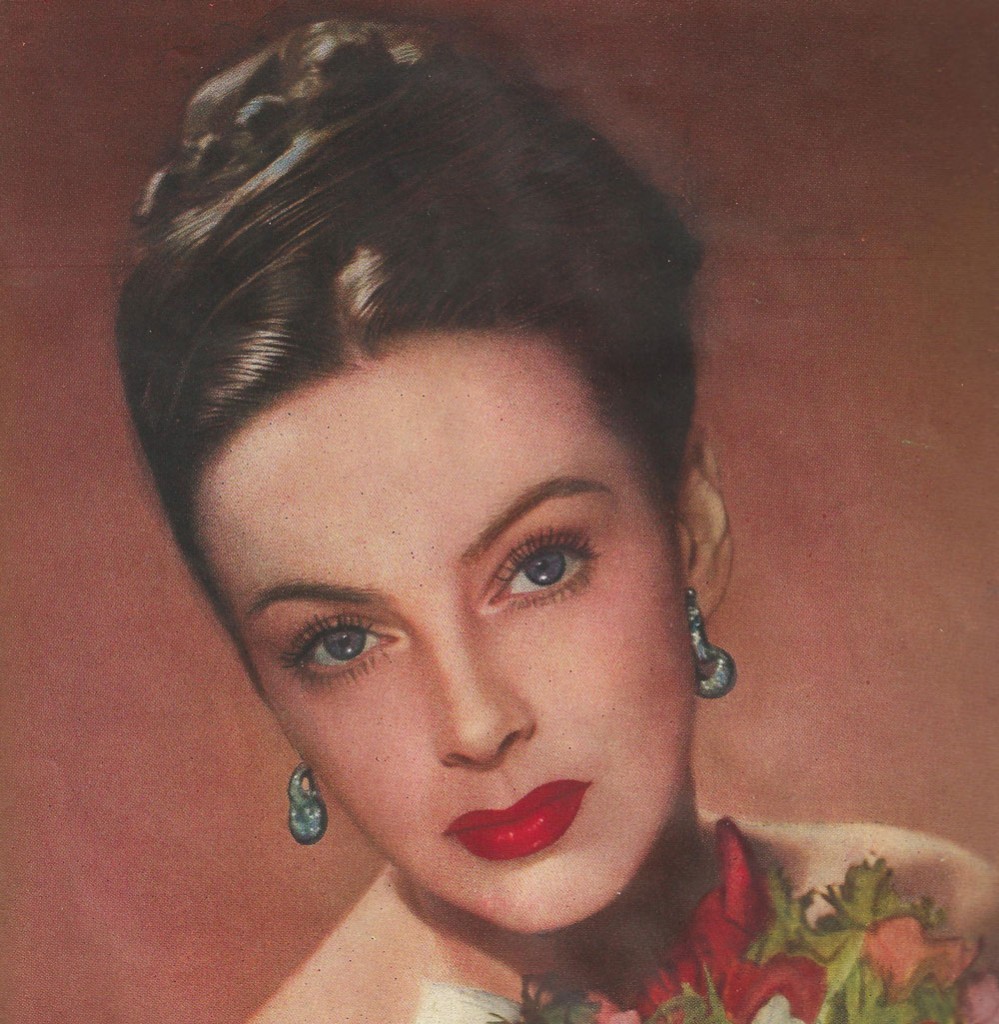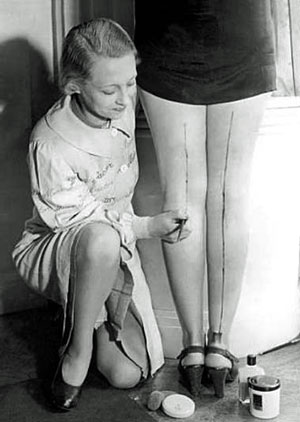
When we think of 1940s makeup we usually think of red lips. This, more than any other aspect of 1940s makeup, defines the era and spans women of all classes from all around the world. But there’s more to 1940s makeup than just red lipstick! Here we look at makeup in general during the decade, how the war affected product availability and the canny way women invented and made do to keep up appearances.
Makeup and Wartime
War. The decade started with much of Europe at war, with other nations worldwide soon to be joining the battle.
Wartime restrictions gradually impacted everyday life and cosmetics were no exception.
Shortages of alcohol meant less cologne; fats and oils were in in short supply (even soap was rationed) and glycerine was a key ingredient in making munitions.
“Such strange things disappeared. No hair clips, curlers, no safety pins.” [1]
Even packaging was affected as metal and plastic were in much need for the war effort, and not readily available for the cosmetic needs of a nation.
In fact, during the war, some cosmetic companies made for the war effort e.g. Revlon factories made first-aid kits and dye markers for the US Navy.
When something was unavailable, rather than go without, women made do and found inventive and resourceful ways to meet their cosmetic requirements.
Makeup substitutes included burnt cork for mascara, cochineal or beetroot juice for lipstick, bi-carbonate of soda for deodorant and gravy browning for leg tint were just some of the creative ways British women kept up appearances.
“The stockings did nothing for morale, they were quite dreadful thick cotton ‘plated’ with rayon. We preferred to tint our legs with dilute gravy browning and draw a ‘seam’ up the back with eyebrow pencil.” [2]
When cosmetic supplies did reach the shops, the word would soon get out and women would queue for hours. Even old theatrical make-up found in second-hands shops was used – it was better than nothing.
“We had no real cosmetics so we dyed our legs to look like stockings and wore beetroot juice for lipstick…” [3]

Advert by Jennifer Graham Cosmetics showing the classic 40s look, including the nod to the Hunter’s Bow lip shape started by Joan Crawford
Lipstick was seen as “good for the morale of the nation” both in Britain and the United States of America.
In the United States, lipstick survived rationing after women protested the War Production Board’s plan to ration it. Women were applauded for the use of lipstick, seen as keeping femininity while carrying out men’s work, and adverts encouraged women to wear lipstick.
The Brits were not so lucky – lipstick was in short supply and very precious!
Petroleum jelly was used to make eye shadow go further, add sheen to lipstick, as well as protect lips from the cold.
“There wasn’t much in the way of make up, just a bit of Pond’s cream and a dab of lipstick.” [4]
Rationing didn’t end as soon as the war finished and was in place in Britain until 1954. However, things slowly but surely came back into regular circulation after the war and more makeup products started to reach the shelves, eagerly bought by women whenever possible.
Influences on Makeup

Drawing a stocking seam with an eyebrow pencil – easier with the help of a friend!
As with the hairstyles of the forties, the movie stars influenced the makeup.
Joan Crawford’s lipstick shape, known as “the smear” or Hunter’s Bow, was created by Max Factor for Joan in the 1930s and was much copied.
Going to the pictures was a popular way to spend an evening and the glamour of the movie stars was admired and copied by women everywhere.
Popular makeup brands include names we still know today: Max Factor, Helena Rubenstein, Elizabeth Arden and Estee Lauder. Others were Gala, Bourjois, Coty, Revlon, Yardley and Rimmel.
Makeup Items in the Forties
The overall makeup look of the 1940s was natural, from pale to slightly tanned skin tones, penciled in brows, a lashing of mascara and a rosy glow to the cheeks, topped off with a splash of red lipstick glamour.
Whatever a woman’s background or class, they always made an effort to look groomed with what little they had.
Lips and Lipstick
Red, red, red! This was the colour of the decade, though there was variation in the red, from the classic pillar box to reds with undertones of blue, brown, orange and pink.
One Gala lipstick advert in the late forties, for example, included the shades Lantern Red; Blaze; Heart Red; Heavenly Pink; Red Bunting; Red Sequin; Cyclamen; Cock’s Comb; Ballet Pink; Chestnut. Yup, the wonderful world of red and close friends.
Lipstick was matte so if a shine was required, a dab of petroleum jelly was applied. Lipsticks were also really staining meaning a little lipstick lasted a long time – perfect for wartime skimping.
It wasn’t just the lipstick colour, but the shape of the lips created that defines the 1940s. After the dinky lips of the ’30s, the fashionable forties Hunter’s Bow lip shape was deep, rounded and full, influenced by the stars of the screen. Lucious lips!
After the war, new lipstick colours started to come in, including lighter colours.
Lip pencils started to make their mark in the late ’40s, simply used to create a lip line which was then filled in with lipstick.
Foundation and Powder
Foundation colours were geared towards “healthy glow” providing a natural look or a slight tanned look, like Helena Rubinstein Beach Tan Foundation and matching powder. Having a sun-kissed glow was popular.
Various brands were on the shelves and came in both matte finishes and those advertised as “having a sheen”, but Max Factor’s Pan-Cake was the winner. Initially developed for the film industry, once actresses saw the results on screen they wanted to use Pan-Cake off screen as well. Seeing an opportunity, the Max Factor brand launched Pan-Cake to the public in the late ’30s and it was a huge success.
To set foundation, a pressed powder in a compact would be used. Ladies, inspired by seeing movie stars use makeup in public, would top up their powder as needed.
Eye Shadows and Liner
Wartime meant eye shadows were hard to come by, so homemade solutions were found.
For example, to create a soft and smoky eye shadow, women could burn a candle under a saucer, producing a sooty residue which could then be mixed with petroleum jelly.
After the war, more coloured eye shadows started to be seen, especially blues and greens.
Eye liner started to be seen on the upper eyelids in the late 1940s.
Mascara
Mascara came in liquid, paste and solid cake formulations, with a little brush. Women would spit onto cake mascara, work it into the colour with the brush before applying the resulting mix to their eyelashes. One of the women we spoke to recalled, “You could get a lovely build up with it!”
During the war, burnt cork could be used as a mascara substitute if you’d run out of the block kind. Mascara predominantly came in black, with blue and brown also being produced.
Eye Brows
Brows were kept groomed, shaped and defined with brow pencil. Brows could be arched or rounded in shape. 1940s brows had more to them than the thin brows of the preceding two decades, but were not left overgrown or too wide or full (unlike the fuzzy caterpillars of the ’80s).
Rouge
Cheek colour was called rouge. Coming in little cardboard pots of compressed powder, popular colours were in the peachy, coral and pink tones.
As rouge was not always available during the war, women could use lipstick to add a hint of colour to their cheeks and, as lipstick was staining, it would last quite well.
Nails and Nail Lacquer
Nail vanish was commonly worn by women of all classes and occupations in the 1940s, and women in adverts always had polished nails.
Generally, nails would be painted to match lips.
Nail lacquer colours were mainly in shades of red and pink, including darker reds and corals. Colourless varnish was used as a top coat.
Other colours were available such as gold, dark green, even black, but red and pinks were the commonest colours by far.
Nails were long and manicured with an oval tip. A manicure that had been seen since the 1920s was the half moon, where the nail’s moon and tips were left unvarnished or whitened. This look probably peaked in the 1930s, but could still be seen on some forties fingers.

Legs and Stockings
Stockings were in short supply in wartime Britain, and eventually in the United States as nylon was taken for the war effort.
Never to be beaten, woman created the illusion of stockings with leg makeup and an eyebrow pencil line drawn up the back of the legs to create the stocking seam. This was fiddly, so not everyone used a line – just colouring legs was better than nothing.
Leg makeup was originally made simply to create a tanned look, then became “liquid stockings” makeup due to the lack of real stockings.
Ankle socks were also worn during the day or for work.
“Like the other young women, I drew black lines down the back of our legs to pretend we were wearing stockings. These were imposable [sic] to get until the Americans Forces arrived.” [5]
For those without leg makeup, products like tea, gravy browning and watered down Camp Coffee (made from chicory) were used to stain the legs, and women may have even used it on their faces to add a tanned look. Other makeup could also be used, such as cake makeup for the face. All was wonderful until caught in the rain!
Find Out More:
Sources:
[1] [2] © Constance M Galilee [3] ©Florence Fryer-Kelsey [4] © Marian Whatton [5] © Irene Currington. WW2 People’s War – an online archive of wartime memories contributed by members of the public and gathered by the BBC. The archive can be found at bbc.co.uk/ww2peopleswar
Corson, R. 2004. Fashions in Makeup: From Ancient to Modern Times. Peter Owen. 664pp.
Peiss, K. 2011. Hope In A Jar: The Making of America’s Beauty Culture. First University of Pennsylvania. 352pp.
Sherrow V. 2001. For Appearances’ Sake: The Historical Encyclopedia of Good Looks, Beauty and Grooming. Greenwood. 288pp.







I’m not sure why but this blog is loading very slow for me. Is anyone else having this issue or is it a problem on my end? I’ll
check back later on and see if the problem still exists.
Sorry it’s loading slowly for you. We do try to optimise everything as much as possible, as we know it’s a “load-heavy website”. (Just checked, the pages come up quickly for me, but I’m on mega-fast broadband.)
Love this site! It’s informative and true to detail for us avid vintages gals!!!!
Hi Debbie, Thanks so much for commenting, really glad you love our site (we try hard to get the facts right!) and happy vintaging!
I am in a play that takes place in 1947 and I am so happy I stumbled onto this website. Thank you for the pictures this has been very helpful!
Hi Andrea, Thank you letting us know – it’s always good to hear that our articles have been useful. Good luck with the play
Love the pictures, great detailed info and has helped my vintage experimentation! Though I’m not spitting into mascara any time soon….!!! Thank you Nx
No spitting in mascara required! Thank you for your comment – happy vintaging